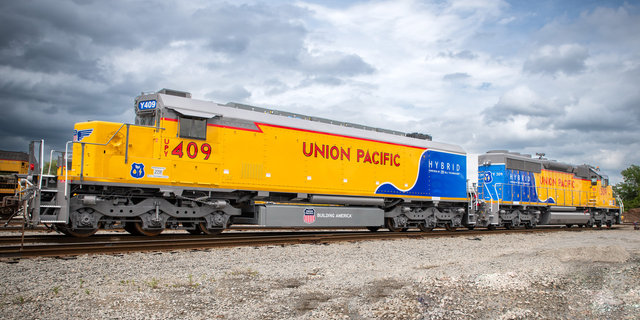
April 29, 2024
Union Pacific Testing First-of-its-Kind Hybrid Locomotive
The first of its kind within North America’s freight rail industry, the prototype has the capacity to run on both diesel and batteries – much like today’s plug-in hybrid cars.
The next of the remaining five hybrid locomotives is expected to be ready for testing next year.
“This is an incredibly exciting pilot project with great potential to improve the fuel efficiency of our locomotive fleet,” said Beth Whited, President of Union Pacific Railroad. “It underscores our strong commitment to exploring and developing alternative energy sources while reducing our carbon footprint and advancing our sustainability goals.”
Union Pacific worked closely with ZTR on the project: ZTR designed the hybrid propulsion technology, while Union Pacific built the prototype at its North Little Rock, Arkansas, facility.
“We are excited about the groundbreaking hybrid technology built in partnership with Union Pacific. Union Pacific is serious about reaching their sustainability goals and they have been an outstanding partner in this project,” said Sam Hassan, CEO and President of ZTR. “The development of the ZTR BLU™ Technology platform is one of the most significant projects for ZTR to date and will be the basis for further advancements in sustainable solutions, including emission-free locomotives.”
The hybrid locomotives will operate as "mother-slug" units, with one locomotive running on diesel and an accessory or “slug” unit providing battery power. The batteries will have multiple charging options, including wayside charging and onboard self-charging capabilities. The engineless slug design increases the number of traction motors available, enhancing the locomotive's pulling and braking power for yard switching work, where trains are built.
Depending on mode of operation, these hybrid switchers are expected to consume as much as 80% less fuel – reducing associated greenhouse gas and criteria pollutants. Additional benefits include reduced maintenance expense and noise compared to traditional diesel units.
Union Pacific has been exploring new technology and innovative approaches to meet its sustainability goals. These include testing and increasing the use of biofuels, using technology to enhance locomotive fuel efficiency, and working with vendors and customers to identify new sustainable synergies.
Since 2018, Union Pacific has cumulatively reduced its GHG Scope 1 and 2 emissions by 19%, with the goal of meeting its science-based target and reducing emissions by 50.4%.
“This is a huge step forward in zero-emission technology. It’s extremely cutting edge, and one of the coolest things I’ve worked on in my career,” said Jason Fox, senior director-Locomotive Engineering and Quality. “If all goes well, we may someday use this technology in all of our rail yards as a switcher set used to build trains.”
Railroads already are one of the most fuel-efficient means of transportation. Moving freight by rail instead of truck reduces GHG emissions by up to 75%. On average, Union Pacific moves a ton of freight 463 miles on a single gallon of diesel fuel.
Union Pacific Unveils Hybrid Prototype
Union Pacific introduces North America's first hybrid locomotive, blending diesel and battery power. Designed in partnership with ZTR, this prototype aims for 80% less fuel consumption.